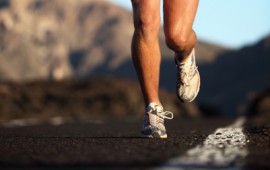Finding the Right Athletic Shoes That Fit
Author: Shannon Miller Lifestyle

Finding the right shoe to work out in is very important.
The right athletic shoes can make all the difference in how you feel during and after your workout.
Choose the wrong athletic shoes and you could end up lying on the couch nursing shin splints or aching heels instead of enjoying a brisk walk or run.
Put yourself a few “steps” ahead of the game by getting it right from the start. Most stores like 1st Place Sports have a specialty staff can help you get that pair of shoes that is just right for you. If you’re looking for custom orthotics, check out our Walk-Fit sponsor, Foot Solutions.
Here is some expert advice to heed before buying new footwear:
- Don’t make shoes multitask – Walking shoes are stiffer; running shoes are more flexible, with extra cushioning to handle greater impact. If you do both activities, get a pair for each one.
- Know your foot- Feet come in a variety of shapes and knowing your foot’s particular quirks is key to selecting the right pair of shoes. Most major brands now offer a model to suit every foot type. You have a neutral arch if your footprint has a distinct curve along the inside and your shoes wear out uniformly. Look for a “stability” shoe, which has the right mix of cushioning and support.
- Measure your foot frequently – “It’s a myth that foot size doesn’t change in adults,” says Steven Raiken, MD. Director of the foot and ankle service at the Rothman Institute at Thomas Jefferson University Hospital in Philadelphia.”It does change as we get older, so have your feet measured twice a year. Sizes also vary between brands, so go by what fits, not by what size the shoe is.”
- Shop toward the end of the day – Feet swell over the course of the day; they also expand while you run or walk, so shoes should fit your feet when they’re at their largest.
- Bring your own socks – The ones you wear while running or walking. If you wear orthotics, bring those, too.
- Don’t believe in breaking in – Running and walking shoes should feel comfortable right away, Raiken tells WebMD. Walk or run around the store a bit to make sure they feel good in action.
- Use the “rule of thumb” – There should be about 3/8-1/2 inch between the front of your big toe and the end of the shoe — about a thumb’s width. The heel should fit relatively tightly; your heel should not slip out when you walk. The upper part of the shoe — which goes over the top of your foot — should be snug and secure, and not too tight anywhere. The American Academy of Orthopaedic Surgeons writes that when fitting in to an athletic shoe you should be able to freely wiggly all of your toes when the shoe is on.
- Understand the bells and whistles – Look for features that actually serve a purpose. Clear inserts, filled with gel, Freon, or air, provide extra shock absorption, as do those springy-looking things. These features are especially good for people who tend to get heel pain, says Raiken, and not so good for people whose ankles twist easily, as shoes with extra cushioning tend to provide less traction.
- Don’t over- or under-pay. Good-quality running and walking shoes are fairly pricey – and usually worth it.
- Know when to replace them. The average pair of running shoes should be replaced after about 350-400 miles of use, says Clifford Jeng, MD, a foot and ankle surgeon at Mercy Medical Center in Baltimore, Md.
Source: webmd.com
